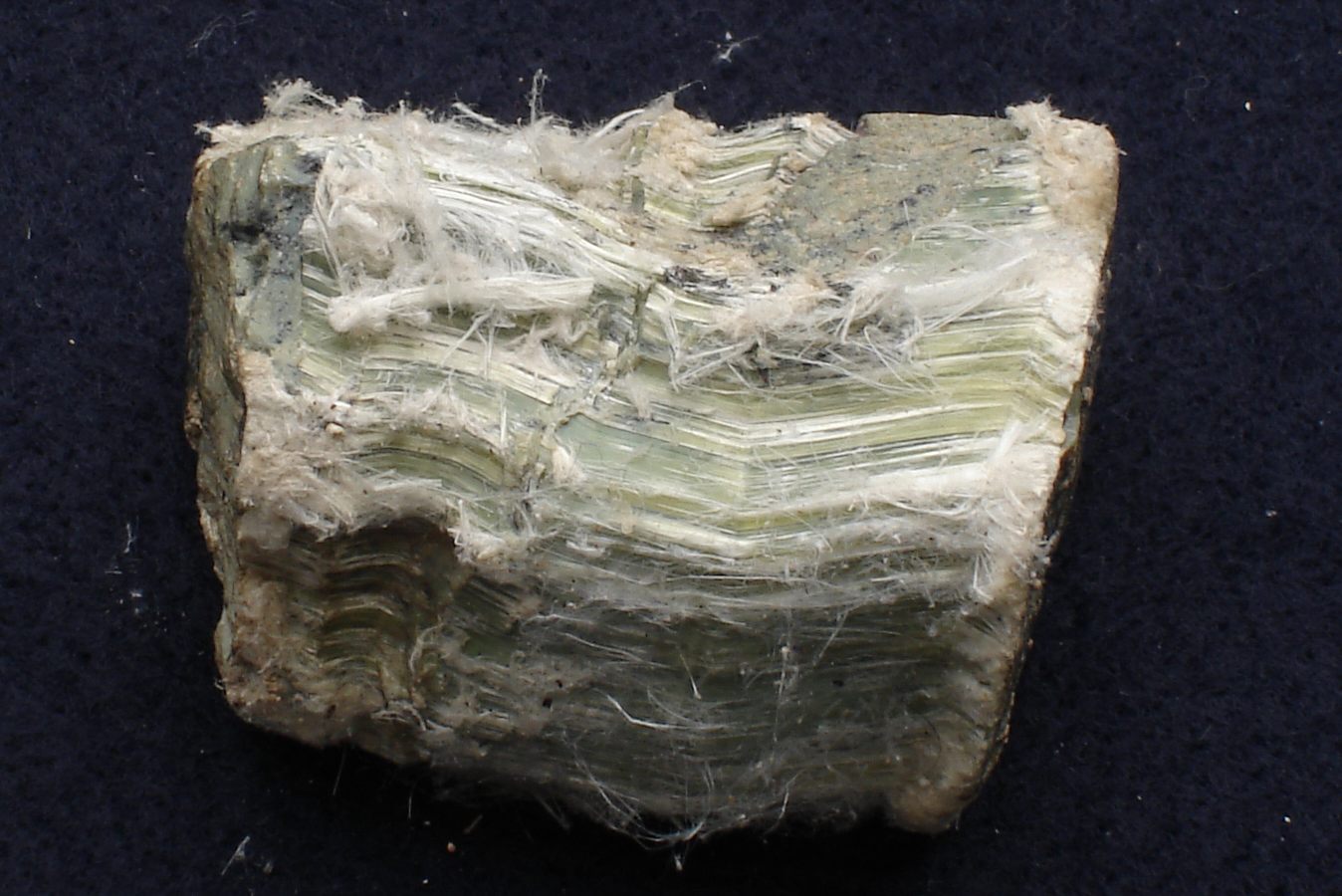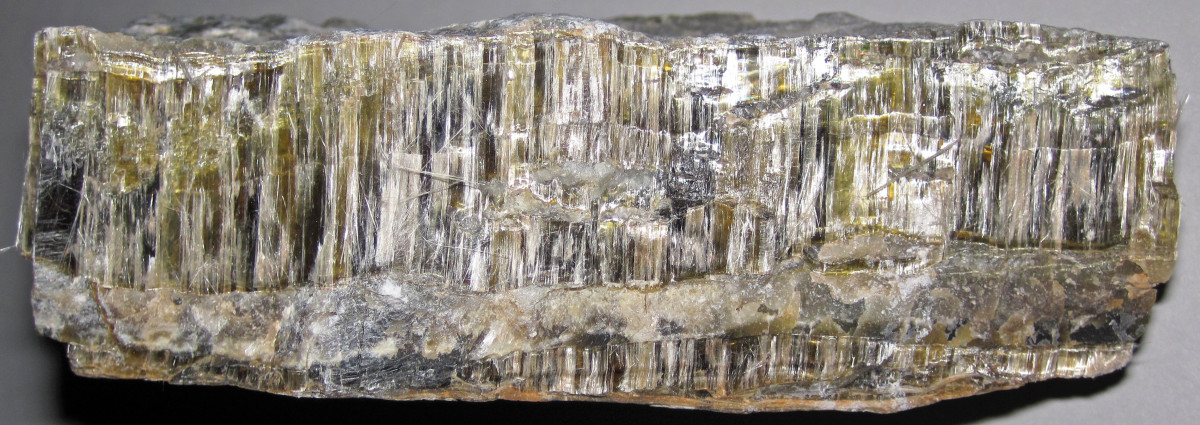
温石棉宝石:特性、含义、价值和安全
 温石棉是一种蛇纹石宝石,常被视作其他宝石的内含物。一个著名例子是翠榴石中的马尾内含物,它显著提升了翠榴石的价值。
温石棉是一种蛇纹石宝石,常被视作其他宝石的内含物。一个著名例子是翠榴石中的马尾内含物,它显著提升了翠榴石的价值。
温石棉是岩石吗?还是矿物?温石棉是一种矿物,而不是岩石。这种矿物的另一个名称是“白石棉”。事实上,温石棉是最常用的石棉矿物。
本指南将向您介绍有关温石棉的所有信息,从其含义和矿物特性到其历史和治疗功效。

关于温石棉
温石棉是一种半宝石和重要的工业矿物,有许多名称,其中大多数都是误称。其中一些不正确的名称包括:
瑞士绿蛋白石
龙鳞石
斑马碧玉
蜥蜴皮碧玉
这些误称的原因主要在于缺乏相关知识。不透明的宝石,尤其是带有花纹的宝石,可能会被卖家简单地称为“ 碧玉”,而不管其真实成分是什么。将温石棉与蛋白石进行比较,很可能是因为温石棉的密度与蛋白石相似。
另一个常见的混淆是温石棉(chrysotile)和橄榄石(chrysolite) 。“chrysolite”是一个相当过时的术语,指的是橄榄石或橄榄石,与温石棉完全不同。
记住它们的一个技巧是,温石棉(想象瓷砖地板中的“瓷砖”)是一种具有多种建筑用途的矿物。
说到温石棉的用途,简单来说,用途非常广泛。
温石棉的用途
全球超过90%的工业石棉是温石棉。仅在美国,温石棉的年消耗量就高达约1.3万吨。
温石棉的一些用途包括:
车辆的刹车片和衬块
垫圈
屋顶(沥青)
水泥板
管道、电器、垫圈和管路的绝缘
粘合剂
乙烯基瓷砖
防火,尤其是干墙
镁的来源
现在您知道了它的用途,那么温石棉是一种什么样的矿物呢?
温石棉规格和特性
温石棉是蛇纹石族的一种矿物。温石棉的近似化学式为Mg3Si2O5(OH)4,也适用于该族的其他成员,例如利蛇纹石和叶蛇纹石,因为它们都是镁质蛇纹石。
温蛇纹石所属的较大类群是石棉组,分为蛇纹石和角闪石。角闪石矿物包括阳起石、透闪石、 透闪石、青石棉(蓝色石棉)和铁石棉(棕色石棉)。
所有石棉矿物均为纤维状。蛇纹石石棉类矿物通常具有由晶片层构成的卷曲纤维,而角闪石类矿物则具有针状纤维。
许多闪石矿物会污染温石棉,使其更容易引起石棉中毒(闪石石棉的毒性比蛇纹石石棉更高)。透闪石、透闪石和阳起石都常污染温石棉、 滑石和蛭石。
以下是剩余温石棉晶体的性质:
莫氏硬度:2.5-3
颜色:白色、金棕色、灰色、绿色或灰绿色;有时为黄色、黄棕色或棕色;可能有纹理或斑点
晶体结构:单斜晶系(斜温石棉);正交晶系(斜温石棉、准温石棉)
光泽: 丝滑
透明度:半透明
折射率:1.56-1.57
密度:2.51-2.63
解理:无
骨折:纤维性骨折
条痕:白色
发光:有时呈淡黄色微弱荧光
多色性:无
光学效果:有时有猫眼效应

温石棉的种类
温石棉有三种多型体,即互为多态性的矿物。这意味着每种类型的矿物具有相同的化学成分,但晶体结构各不相同。
斜晶石棉:最常见的类型,具有单斜晶系
正温石棉:稀有类型,具有正交晶系,折射率沿纤维长轴方向较高
副温石棉:非常罕见的类型,具有正交晶系,垂直于纤维长轴方向的折射率较高
还有三种重要的温石棉需要了解:
铝温石棉:富含铝的品种
石棉:具有石棉状习性的品种(易于分离的纤维的集合体,这些纤维柔韧、细长且难以断裂)
伊什基尔德石:含硅较多的品种,其光学特性与其他温石棉类型不同
您了解所有关于矿物的知识,但是温石棉蛇纹石的含义又是什么呢?
 图片来源:Eurico Zimbres | Creative Commons Attribution-Share Alike 2.5 通用许可证
图片来源:Eurico Zimbres | Creative Commons Attribution-Share Alike 2.5 通用许可证
温石棉的意义和历史
温石棉象征着自我反省、力量和韧性。它在灵性界被昵称为“生命之石”。这种水晶也是双子座的幸运石。
绿色斑马碧玉石棉或龙鳞石的误称也使温石棉在过去获得了帮助佩戴者识别和抵御邪恶或厄运的声誉。
然而,温石棉的现代历史很大程度上是处于温石棉暴露的危险之中。
早期历史
我们先从温石棉的发现说起。1843年,德国矿物学家弗朗茨·冯·科贝尔首次为来自加拿大的温石棉样本命名。他取自希腊语“chrysos ”(意为“黄金”)和“ tilos ”(意为“纤维”),以此命名温石棉,暗示了这种石头的金色纤维。
在使用当前名称之前,温石棉的其他矿物学名称有:
加拿大石棉
费萨尔蛇纹石
温石棉-α 或 α-温石棉
库菲石/库菲石
莱夫卡斯贝斯特/莱夫卡斯贝斯托斯
苦味剂/皮克罗斯明
塞浦路斯人
钾长石
克里索利斯
石棉禁令
在整个20世纪,温石棉是美国石棉产品的主要成分。事实上,加拿大和美国曾是温石棉的主要产地。
那么,温石棉何时被禁用?
简短的回答?比你预期的要晚得多。稍微长一点的回答是:
石棉的使用可以追溯到公元前2400年,而早在公元1世纪就有记录表明石棉可能与疾病有关。然而,第一份关于石棉中毒的官方记录出现在1924年的《英国医学杂志》上。
这篇医学文章发表于 1874 年加拿大第一座商业化生产的石棉矿开采 50 年后。20 世纪 30 年代,ERA Merewether 医生首次列出了石棉中毒或石棉肺的症状。
在英国,梅里韦瑟的研究帮助政府制定了对石棉工厂工人的保护措施,但没有为安装石棉产品的人提供保护。
20 世纪 40 年代,有大量记录表明石棉会导致疾病或癌症。1949 年,《大英百科全书》将石棉称为“职业性和环境性癌症的病因”。尽管大量研究表明石棉存在危害,但直到 1969 年,英国才颁布了重要的法规。
在澳大利亚,温石棉自2003年起被禁止使用。政府早在20世纪60年代就开始逐步淘汰石棉的使用。
20世纪70年代,美国开始制定针对石棉肺的法规。尽管美国环境保护署(EPA)在20世纪90年代初试图逐步淘汰石棉,但美国法院阻止了这项禁令。
自 2022 年 4 月 5 日起,美国环保署正试图颁布一项禁止温石棉的法令,以保护制造商、安装商和消费者。
我们将在“保养与维护”部分进一步讨论安全问题。但现在,我们先来聊聊精神健康,看看温石棉的一些疗愈功效!
 图片来源:James St. John | Flickr
图片来源:James St. John | Flickr
温石棉的治疗特性
所有宝石都具有疗愈功效,其能量受其颜色影响。许多温石棉呈绿色,与其他绿色宝石一样,具有促进活力和生长的作用。
黄色温石棉具有黄水晶的益处,例如能提升希望、喜悦和创造力。同时,棕色温石棉则具有棕色宝石的接地和平衡特性。
那么具体的身体、情感和脉轮治疗用途又如何呢?
身体康复
温石棉的物理治疗功效并不强。其主要物理用途是治疗与血液循环和视力相关的问题。
情绪疗愈
温石棉据称具有情绪疗愈功效,包括帮助你释放消极的思维模式或行为模式。据说,温石棉还能在你克服过去情感困境的痛苦时保护你的自我意识,帮助你保持冷静,从错误中汲取教训,而不是因此而自责。
脉轮疗愈
古代人们使用脉轮石来打开阻塞的能量中心(脉轮)以解决负面症状。
众所周知,宝石的颜色会影响疗愈。与其他白色宝石一样,白色温石棉是顶轮的脉轮石,能够开启灵性提升和更高的意识。
另一方面,绿色温石棉是一种用于平衡心轮的脉轮石,可以带来对自己和他人的爱之情。
一颗开放的心在情感上是宝贵的,但温石棉作为宝石的价值是什么?
温石棉宝石特性
与大多数宝石一样,温石棉的价值取决于每颗特定宝石的颜色、切工、净度和处理方式。
颜色
尽管温石棉被称为“白石棉”,但大多数经过抛光并作为宝石出售的温石棉都是灰色或绿色的。它们几乎总是带有纹理或斑点,通常为白色和灰色,或中到深绿色和白色。有时,温石棉呈棕色或黄色。
切
几乎所有温石棉都被切割成凸圆形、球形或滚石形状。您经常会在吊坠和耳环中看到凸圆形温石棉。 刻面温石棉几乎不存在。
您还可以看到雕刻的温石棉,例如塔形、心形或魔杖形。
明晰
除了罕见的马尾内含物可以使翠榴石变得非常珍贵之外,其他宝石中的大多数温石棉内含物也会降低宝石的价值。
温石棉本身的内含物并不常见。然而,这种石头的纤维有时能像其他内含物一样,赋予珍贵的光学现象——猫眼效应。
治疗
许多温石棉会被染色,以呈现出更明亮或更有趣的颜色。它们也可能被注入树脂,以提高稳定性和耐用性。
处理通常会降低宝石的价值(尤其是染色),因此卖家应始终披露温石棉宝石(或任何宝石)是否经过处理。
 图片来源:James St. John | Flickr
图片来源:James St. John | Flickr
温石棉的形成与来源
温石棉矿物的典型形成过程与叶蛇纹石和蜥蜴石相似:超镁铁质岩的热液蚀变(又称低级变质作用)。
当富含矿物质的水渗入岩石缝隙时,它会改变内部的矿物质。之前的矿物质会变成新的矿物质——在这种情况下,橄榄石或斜方辉石通常会变成温石棉。
常见的含有温石棉的岩石有蚀变白云石石灰岩和蛇纹岩。
采矿地点
温石棉在哪里开采?温石棉的主要产地有:
巴西
加拿大
中国
哈萨克斯坦
波兰
俄罗斯
津巴布韦
回答买家最关心的关键问题:温石棉宝石的价格是多少?
 图片来源:James St. John | Creative Commons Attribution 2.0 通用许可证
图片来源:James St. John | Creative Commons Attribution 2.0 通用许可证
温石棉的价格和价值
市面上常见的温石棉主要有凸圆形和滚石两种。大多数温石棉带有白色条纹,底色为中绿色至深绿色或灰色至黑色。
温石棉凸圆形宝石和滚石价格非常实惠。大多数价格低于每克拉 1 美元,单颗宝石的价格约为 5 至 8 美元。
心形、塔形和魔杖等雕刻品的价格略高,每件约 15 美元,而更大尺寸的雕刻品每件价格约为 30 美元。
温石棉安全与护理
在讨论宝石保养之前,我们先来了解一下如何安全地处理温石棉。幸运的是,闪石类石棉矿物比蛇纹石石棉危险得多,但这并不意味着温石棉完全安全。
首先,温石棉的含量高到什么程度才算危险?大多数专家认为,任何比例的温石棉都是危险的。然而,温石棉的危险之处在于其释放的纤维被吸入体内。因此,除非被压碎,否则抛光石材不会构成危险。
话虽如此,宝石切割师在切割温石棉时仍需采取预防措施——例如,隔离工作区域,佩戴合适的安全设备,包括口罩、护目镜和手套。此外,大多数安全专家建议在宝石湿润时进行切割,因为干切会导致更多纤维释放。
每天购买者都需要小心处理粗糙的标本,最好将它们存放在密封的容器中以防止吸入纤维。
开始宝石护理!
宝石护理
虽然温石棉不会溶解在水中,但它的纤维会在稀释的酸中开始分解,所以不要让任何酸靠近石头。
对于温石棉珠宝,我们建议采用保护性镶嵌,以解释这种宝石在莫氏矿物硬度等级上的较低等级。
您可以使用标准软牙刷、温水和温和肥皂清洁(抛光)温石棉。请将其与其他宝石分开存放,以免刮伤。
渴望获得温石棉水晶吗?
别让石棉的成分吓到你——抛光温石棉不仅安全使用,还能带来诸多益处,例如治愈情绪、抵御不良情绪。价格实惠,图案夺目,还有什么理由不爱呢?
搜索Gemstone Encyclopedia
最新的文章
彩虹格纹日光石是一种长石,由于内部含有各种包裹体,呈现出三种绚丽的光学效应。它绚丽多彩的光泽和格纹图案使其成为收藏家梦寐以求的珍宝!
12th Jan 2026
文章分类
How To's is where you will find helpful articles from gem Rock Auctions on how to cut gemstones, select gemstones and buy gemstones.
9文章数

